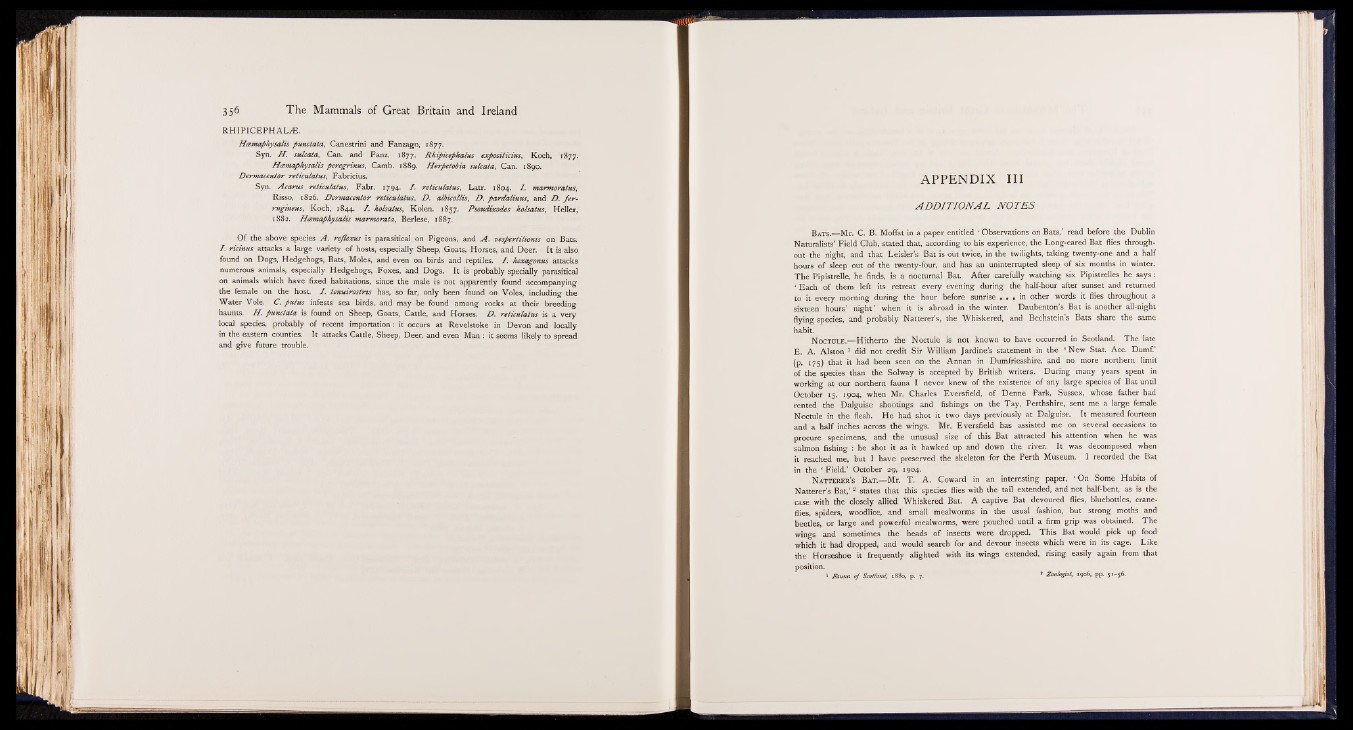
RH IP IC E PH A L /E .
Hcemaphysalis punctata, Canestrini and Fanzago, 1877.
Syn. H . sulcata, Can. and Fanz. 1877. Rhipicephalus expositicius, Koch, 1877.
Hcemaphysalis peregrinus, Camb. 1889. Herpetobia sulcata, Can. 1890.
Dermacentor reticulatus, Fabricius.
Syn. Aca rus reticulatus, Fabr. 1794. /. reticulatus, Latr. 1804. I . marmoratus,
Risso, 1826. Dermacentor reticulatus, D . a lbicollis, D . pardalinus, and D . fe r ruginous,
Koch, 1844. I . holsatus, Kolen. 1857. Pseudixodes holsatus, Heller,
1882. Hcemaphysalis marmorata, Berlese, 1887.
O f the above species A . reflexus is parasitical on Pigeons, and A . vespertilion is on Bats.
/. ricinus attacks a large variety o f hosts, especially Sheep, Goats, Horses, and Deer. It is also,
found on Dogs, Hedgehogs, Bats, Moles, and even on birds and reptiles. I . hexagonus attacks
numerous animals, especially Hedgehogs, Foxes, and Dogs. It is probably specially parasitical
on animals which have fixed habitations, since the male is not apparently found accompanying
the female on the host. /. tenuirostris has, so far, only been found on Voles, including the
Water Vole. C . putus infests sea birds, and may be found among rocks at their breeding
haunts. H . punctata is found on Sheep, Goats, Cattle, and Horses. D . reticula tus is a very
local species, probably o f recent importation: it occurs at Revelstoke in Devon and locally
in the eastern counties. It attacks Cattle, Sheep, Deer, and even M a n : it seems likely to spread
and give future trouble.
A P P E N D IX I I I
A D D IT IO N A L N O T E S
B a t s .— Mr. C. B. Moffat in a paper entitled ‘ Observations on Bats,’ read before the Dublin
Naturalists’ Field Club, stated that, according to his experience, the Long-eared Bat flies throughout
the night, and that Leisler’s Bat is out twice, in the twilights, taking twenty-one and a half
hours o f sleep out o f the twenty-four, and has an uninterrupted sleep o f six months in winter.
T h e Pipistrelle, he finds, is a nocturnal Bat. After carefully watching six Pipistrelles he s a y s :
‘ Each o f them left its retreat every evening during the half-hour after sunset and returned
to it every morning during the hour before sunrise • • » in other words it flies throughout a
sixteen hours’ night’ when it is abroad in the winter. Daubenton’s Bat is another all-night
flying species, and probably Natterer’s, the Whiskered, and Bechstein’s Bats share the same
habit.
N octule.— Hitherto the Noctule is not known to have occurred in Scotland. T he late
E. A . Alston 1 did not credit Sir William Jardine’s statement in the ‘ New Stat. Acc. Dumf.’
(p. 175) that it had been seen on the Annan in Dumfriesshire, and no more northern limit
of the species than the Solway is accepted by British writers. During many years spent in
working at our northern fauna I never knew o f the existence o f any large species o f Bat until
October 15, 1904, when Mr. Charles Eversfield, o f Denne Park, Sussex, whose father had
rented the Dalguise shootings and fishings on the T ay, Perthshire, sent me a large female
Noctule in the flesh. H e had shot it two days previously at Dalguise. It measured fourteen
and a half inches across the wings. Mr. Eversfield has assisted me on several occasions to
procure specimens, and the unusual size o f this Bat attracted his attention when he was
salmon fishing : he shot it as it hawked up and down the river. It was decomposed when
it reached me, but I have preserved the skeleton for the Perth Museum. I recorded the Bat
in the ‘ Field,’ October 29, 1904.
N atterer’s Bat.— Mr. T . A . Coward in an interesting paper, ‘ On Some Habits of
Natterer’s Bat,’ 2 states that this species flies with the tail extended, and not half-bent, as is the
case with the closely allied Whiskered Bat. A captive Bat devoured flies, bluebottles, crane-
flies, spiders, woodlice, and small mealworms in the usual fashion, but strong moths and
beetles, or large and powerful mealworms, were pouched until a firm grip was obtained. The
wings and sometimes the heads o f insects were dropped. T his Bat. would pick up food
which it had dropped, and would search for and devour insects which were in its cage. Like
the Horseshoe it frequently alighted with its wings extended, rising easily again from that
position.
* Zoologist,1 Fauna o f Scotland, 1880, p. 7. 1906, pp. 51-56.